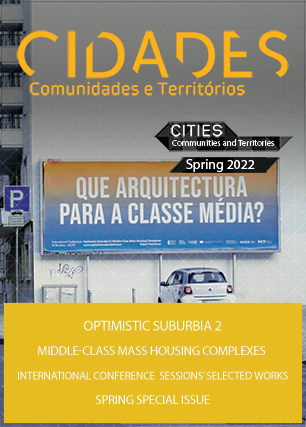The history of the Cité Balzac and the vicious circle of social housing
Palavras-chave:
social housing in France, Paris' red suburbs, urban renewal in the 2000sResumo
The history of the Cité Balzac, a housing complex built in the 1960’s in Vitry-sur-Seine, an emblematic “red suburb” in the south of Paris, reveals several transformations on public housing policies in France and some permanencies throughout five decades. Originally built to provide affordable housing for the inhabitants of problematic neighbourhoods within Paris, this large-scale complex inspired by post war architectural models and organized following functionalist urban-ism schemes has been initially occupied by an emerging middle class that left the apartments when private property became encouraged by a liberal government during the 1970’s. The social housing apartments were by then occupied by impoverished immigrants and French citizens coming from former colonies and became stigmatized as a symbol of social problems and ethnic conflicts. Recently, even being situated in a municipality dominated by the French Communist Party since 1920’s, the Cité Balzac was the epicentre of an intense urban renovation project led by the National Agency for Urban Renewal (ANRU), giving room to a controlled gentrification process that tried to erase the image of sensible neighbourhood that characterized this territory and its surroundings with the demolition of the bigger blocks and the ‘residentialization’ of the smaller ones. This project opened space for new housing blocks built by real estate and public works contractors based on private property to be occupied by middle class families that couldn’t afford to buy in Paris intramuros. This controlled gentrification happened gradually as the Grand Paris project was taking place, expanding the limits of the French capital to its closer suburbs with the extension and improvement of the public transportation system, feeding a vicious circle that raises fundamental issues about the role of social housing and its contradictions.
Referências
Bellanger, E., & Mischi, J. (2013). Les territoires du communisme Élus locaux, politiques publiques et sociabilités militantes, Paris: Armand Colin/ Recherches CHS.
Butler, R., & Noisette, P. (1983). Le logement social en France (1815- 1981). In De la cité ouvrière au grand ensemble. Paris: La Découverte/ Maspero, pp.6-7.
Canteux, C. (2014). Filmer les grands ensembles Collection «Lieux habités». Paris: Créaphis.
Coing, H. (1966). Rénovation urbaine et changement social. Paris: Les éditions ouvrières.
Donzelot, J. (2009). La ville a trois vitesses. Paris: Éditions de La Villette.
Engels, F. (1935). The Housing Question, New York: International Publishers.
Monnier, G., & Klein, R. (2002). Les années ZUP : architectures de la croissance, 1960-1973. Paris: Picard.
Sfeir, N. (2013). Realurbanism: or the Urban Realpolitik.Towards a ‘Spatialisation’ of the Realist Paradigm, International Relations Theories Journal of Settlements and Spatial Planning, 4 (1), 1–10. https://hal.archives-ouvertes.fr/hal-01828901.
Urban, F. (2012). Tower and slab - Histoiries of global mass housing. London/Nova York: Routledge.
Vayssière, B. (1988). Reconstruction-Déconstruction. Le hard french ou l'architecture française des Trente Glorieuses. Paris: Picard.
Voldman, D. (2010). Désirs de toit. Paris: Creaphis.
Downloads
Publicado
Edição
Secção
Licença
Direitos de Autor (c) 2022 Diego Inglez de Souza

Este trabalho encontra-se publicado com a Licença Internacional Creative Commons Atribuição-NãoComercial-SemDerivações 4.0.
Cidades, Comunidades e Territórios by DINÂMIA'CET-IUL is licensed under a Creative Commons Atribuição-Uso Não-Comercial-Proibição de realização de Obras Derivadas 4.0 Unported License.Permissions beyond the scope of this license may be available at mailto:cidades.dinamiacet@iscte.pt.







